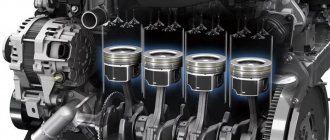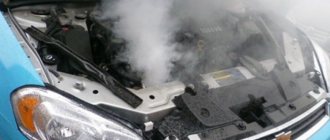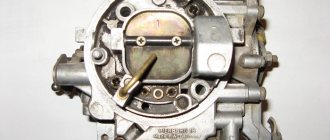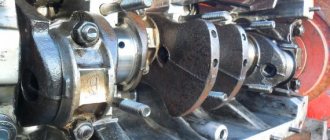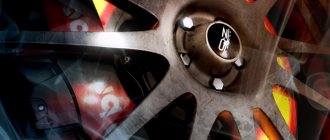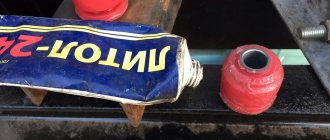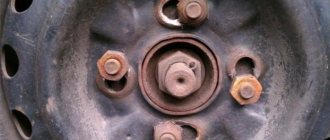Published: 01/28/2021
- Causes and diagnosis of timing belt problems. How can you recognize signs of trouble and what should you keep in mind when installing a new timing chain kit?
- POPULAR
- Signs of wear
- Incorrect replacement
- Phases of the GRS mechanism
- After replacing the timing chain or belt, the engine does not start: main causes and troubleshooting
- How to correctly set marks during the process of replacing/installing a belt on a “nine”
- Operation of the gas distribution mechanism
- Main timing components
- After replacing the timing chain or belt, the engine does not start: main causes and troubleshooting
- Timing belt repair process
- Timing belt diagnostics
- How and who can wear “Kolovrat”
- Thermal expansion problem
- After replacing the timing belt, the car does not start? Several reasons why
- Incorrect replacement
Signs of wear
Several symptoms will indicate a worn chain. To avoid having to overhaul the engine (which is usually very expensive), it is necessary to change the chain as it stretches.
If the engine idles roughly and unevenly, then the chain is already “fit.” This type of engine operation is due to the fact that the valve timing has changed. If the chain chirps at idle, then this is also one of the signs that irreparable malfunctions of the timing drive may soon occur.
If, after removing the cover, it is clear that the tensioner has reached its maximum distance, if wear appears on the teeth of the sprockets, then it is best to replace the chain.
Incorrect replacement
Often a problem with engine starting occurs during a scheduled belt replacement. This is mainly due to incorrect assembly. In this case, the phases do not match. In practice, it turns out that the compression stroke ends in one cylinder, and the spark hits the other
Therefore, it is important to make the replacement carefully and carefully.
Mismatch of marks on the pulleys is a fairly common mistake among novice mechanics. Many people forget to turn the engine on them. As a result, the spark cannot meet the piston. Be sure to check the position of the marks. Remember that the rotation speed of the crankshaft is different from that of the camshaft. To accurately determine the position of the fourth cylinder at top dead center, you should unscrew all the spark plugs.
A rubber plug is inserted into the fourth cylinder; instead, you can take a disposable plastic bag; they also clog the hole for the spark plug. When the engine “shoots” the plug, the cylinder will be right near the dead center of the compression stroke.
All that remains is to move it up a little, checking the position with a screwdriver. After this, the position of the marks is checked. The bottom one will naturally match. Well, unless of course you touched the crankshaft
So pay attention to the top one. If it doesn't match, then that's the reason.
Remove the belt and align the camshaft pulley according to the marks. Then install the belt and try to start the engine. Most likely it will start.
Also on some models there is a mark on the flywheel. Few people know about her. But it must also match. Often the reason for the engine not starting after replacing the timing belt is precisely this. Keep in mind that the flywheel is often dirty, and it can be quite difficult to see the mark there. Therefore, be careful.
On carburetor engines, when replacing the belt, the ignition may be disrupted. More precisely, the compression stroke moves from the fourth cylinder to the first. This is a sign of unskilled assembly. You should adjust everything according to the marks again. If you need to drive right now, this happens, then you can swap the high-voltage wires of the fourth and first cylinders. This will help you start the car without problems.
Details
. Some drivers, trying to save money, do not buy new rollers. In this case, the installed belt simply slips and the car does not start. The same problem can happen if the components are selected incorrectly. Always purchase belts and pulleys recommended by the manufacturer. Also, the entire timing drive must be replaced; partial replacement can lead to breakdowns.
Conclusion
. Replacing the gas distribution mechanism drive is a rather complex and responsible procedure. Even with experienced mechanics, it may happen that after replacing the timing belt, the car does not start. If newbies get down to business, then this is generally a common occurrence. In this regard, carefully study the rules for replacing the drive, as well as all possible causes of further malfunctions.
The simplest malfunctions and methods for eliminating them
First of all, of course, it’s worth talking about the security system. The fact is that when arming, the engine is blocked. And until the alarm is turned off, the engine cannot be started. It is possible that the starter will spin, but the spark will not be supplied to the spark plugs
Immediately pay attention to the LED indicator that shows the alarm is working
There are often cases when motorists install secret buttons themselves. When buying a car, be sure to ask the owner if the car has one. Because when cleaning the interior or doing repairs, you can accidentally catch it. This anti-theft system is very simple. One terminal of the switch is connected to ground, and the second to the signal wire of the Hall sensor. The symptoms are the same as when the alarm is on. The engine spins but there is no spark. The way out of the situation is to disconnect the wire going to the tachometer in the block above the vacuum brake booster.
Another commonplace malfunction is the breakdown of the Hall sensor itself. The symptoms are the same as in the two previous cases. True, sometimes, in the event of a partial failure, a spark may occasionally jump out and the engine will make several “sneezes”. Only replacing the sensor will help. To do this, you need to disassemble the ignition distributor. Often the wire simply breaks. Therefore, in the event of a breakdown on the road, the best solution would be to insulate the wire and drive to the repair site.
Phases of the GRS mechanism
The phases of the gas distribution system are precisely what makes the car engine function simultaneously, without disruption. If these very phases go astray, then either the piston will not reach TDC at the right time, or the valve will lag behind, in a word, problems are inevitable.
The phases of the gas distribution system are always set according to the markings, due to which clear and synchronous operation of the motor is achieved.
Phases of the GRS mechanism
If you need to set the timing marks correctly, you will have to remove the belt. You will have to stock up on keys, screwdrivers and all those tools that will make the work easier. For example, a wrench for socket heads - this is convenient for attaching a nut almost anywhere.
Every expert will confirm that the GDS phases must be installed from the factory. But during active operation of the engine, repairs, etc., the phases shift, the car begins to pull poorly and the motor vibrates.
Algorithm for carrying out an operation to diagnose the correctness of marks:
- The top belt protection cover is removed.
- The gearbox switches to 4th.
- The car is pushed forward until the marks on the shaft coincide with the markings on the cover (bottom).
- Now you need to look under the hood.
- Here, find the clutch housing, remove the rubber lock from it, which blocks access to the hole through which the mark on the flywheel is clearly visible.
Messages 5
1 Topic by K4o5 2013-09-30 22:22:32
- K4o5
- New member
- Inactive
- Registration: 2013-08-05
- Messages: 13Thanks: 4
- Car: VAZ21101
Topic: Resolved: Stopped starting after replacing timing belt
Actually the background. For the time being I drove normally, sometimes at speeds of 160 km/h and in traffic jams, no complaints. But one night, it stalled while I was standing at a traffic light in neutral. repeated attempts to start it to no avail. drove it away and removed the timing case. Here I discovered that the belt itself was intact, but one gap of 10-15 cm was completely without teeth. well, it doesn’t happen to anyone, it was decided to replace the bearing and pump along with the timing belt. disassembled, marked, put back together and EVERYTHING. it won't start and that's it. The fuel pump pumps, the engine sneezes, but does not start. We decided to have a light. no sense. We decided (!) to pull in 2nd gear, the check light is on, there are revolutions, but again no result. We smoked, scratched, spat and went home. Help me with advice on what to do? car 21101 engine 1.6 8kl
2 Reply from Admin 2013-10-01 05:25:14
- Admin
- Administrator
- Inactive
- Registration: 2012-02-20
- Messages: 3,257Thanks: 624
Re: Solved: stopped starting after replacing the timing belt
K4o5, check the pressure in the fuel system https://xn--2111-43da1a8c.xn--p1ai/repea … rampe.html and whether there is a spark
3 Reply from jora33rus 2013-10-01 07:52:57
- jora33rus
- Participant
- Inactive
- From: Vladimir region
- Registration: 2013-03-09
- Messages: 34Thanks: 20
- Auto: 2111
Re: Solved: stopped starting after replacing the timing belt
In theory, the valve couldn’t have been bent by 8kL, so I don’t think it’s anything serious. It’s also worth looking at the crankshaft position sensor and the pulley adjacent to it, is it tightened? Are the tags set correctly?
4 Reply from aleksandr102rus 2013-10-03 13:34:52
- aleksandr102rus
- New member
- Inactive
- From: Bashkiria, Kumertau
- Registration: 2013-10-03
- Messages: 1 Thanks: 1
- Car: VAZ 2112
Re: Solved: stopped starting after replacing the timing belt
Yes, check the pulley; sometimes it sits crooked and then it will cause a lot of problems. One friend already had this done and his whole head was broken, why wouldn’t it start?
5 Reply from K4o5 2013-10-03 20:45:36
- K4o5
- New member
- Inactive
- Registration: 2013-08-05
- Messages: 13Thanks: 4
- Car: VAZ21101
Re: Solved: stopped starting after replacing the timing belt
In short, it was not the reel))) For the future, for me and for everyone who doesn’t know. On the flywheel, in addition to the risk that needs to be set, there are some kind of holes. My flywheel is not exactly dirty, but like a CPU in the barracks it is not clean. So, instead of the risk, I put the edge of this hole, since it is somewhat similar to this risk. More info for the future: 1. the camshaft (the one on top) makes ONE revolution, the crankshaft (like the flywheel) makes TWO revolutions. That is, after you have set the marks and marks and pulled the cigarette out of your mouth, but the car does not want to start, turn the flywheel one more revolution. 2. I tightened the timing belt as follows: I set the marks of the camshaft and flywheel JUST below the level. When you tighten the belt and if you decide to drink alone, it will help. Why, you will understand for yourself. 3. After your hellish tarantas has deigned to start and you have driven the first kilometers, do not be alarmed by the new noises of the car. At least the sound from under the hood has changed a little (most often I drive without music, so I know where everything is and how it makes noise in my car)
It will be useful: Removing and replacing front brake pads on Lada Kalina
After replacing the timing chain or belt, the engine does not start: main causes and troubleshooting
Before diagnosing the timing drive, it is recommended to immediately check the proper operation of the ignition system, the condition of the battery, the correct connection of parts of the power system, electrical sensors of the ECM, etc. If no defects are identified, then we move on to the gas distribution mechanism drive.
Similar malfunctions can occur on various car models. First, it is important to know that mistakes when replacing the timing drive can lead not only to failures, but also to further breakdowns. It is also necessary to separately take into account the reason why the drive elements had to be changed.
Possible reasons
First, you need to understand what you've recently done to the engine. This is the only way to determine the possible cause of the malfunction. For example, if the car does not immediately pull after replacing the timing belt, then, of course, you should check the condition of the element. There can be many reasons why the car does not pull and the engine power drops. Let's look at the most common of them:
- First, you need to check the installation of the timing belt (the marks may be set incorrectly, which is why the car does not pull).
- Diagnose the functioning of the injection nozzles - sometimes the problem lies precisely in clogged injectors. If your vehicle is equipped with a carburetor engine, then you need to check its settings. The carburetor may be clogged and will need to be cleaned.
- Check the ignition (if it is too late or too early, then there may be a problem with the engine power).
In addition, other problems may be causing the loss of power. For example, a clogged fuel filter. But we will look at solutions to common problems.
How to correctly set marks during the process of replacing/installing a belt on a “nine”
The timing belt on cars with front-wheel drive is carried out using a toothed belt. Each successive replacement of the AvtoVAZ belt is recommended after 65,000 miles. In addition to replacing the element itself, it is also recommended to change the roller.
The algorithm for replacing the timing belt is as follows:
- First of all, a new belt and roller are purchased (it is advisable that both elements are recommended by the car manufacturer);
- The car is placed on a level surface;
- The battery is de-energized (due to the exception of a short circuit during the work process);
- The car is secured with special anti-rollback stops;
- The protective cover is removed from the timing system;
- The power unit is set according to the marks.
Tips and tricks
When replacing the timing belt, the rollers should also be replaced. Otherwise, the old rollers may jam, which will lead to a timing belt break.
When replacing, you should select either original parts for this model, or their high-quality analogues, but only those recommended by the manufacturer itself. You need to be wary of numerous fakes.
The service life of the belt is significantly reduced by severe vehicle operating conditions. For example, driving in the cold season on a cold engine increases wear on parts.
Operation of the gas distribution mechanism
The principle of operation on all engines, when it comes to types such as internal combustion engines, is almost the same. All work can be divided into 4 stages:
- fuel injection;
- compression;
- duty cycle;
- removal of exhaust gases.
Fuel is supplied to the combustion chamber by moving the crankshaft from top dead center (TDC) to bottom dead center (BDC). When the piston begins to move, the intake valves open and the fuel-air mixture is supplied to the combustion chamber. After this, the valve closes, during which time the crankshaft rotates 180 degrees from its original position.
After the piston reaches BDC, it rises up. Consequently, the compression phase begins. When TDC is reached, the phase is considered completed. At this time, the crankshaft rotates 360 degrees from its initial position.
Differences between carburetor and injector breakdowns
There are common cases of engine starting failure for the injector and carburetor. But now let’s look at the distinctive features of such a malfunction as a “stalled engine”. The differences in troubleshooting are due to the different operating principles of the two systems.
The VAZ 2109 has a carburetor - the engine is driven by sucking the combustible mixture into it. This occurs due to the fact that a pressure difference is formed in the intake manifold and the atmosphere. In this case, three components are sufficient to start the machine normally:
- gasoline;
- air;
- sparks.
The starter rotates the crankshaft, and the resulting mixture (fuel and air) is sucked into the cylinder cavity. Next, the valves of the internal combustion engine close, a compression stroke occurs, at the end of which a spark appears on the spark plug and the combustible mixture is ignited. The engine starts.
And in the case of an injector, fuel injection and the quality of the resulting mixture are controlled and adjustable. The combustible mixture is pumped into the cylinders using nozzles (directly into the combustion chamber). Therefore, there is no need to create conditions for the absorption of air and gasoline here.
In addition, the VAZ 2109 injector has many sensors, an electronic control unit and an electric fuel pump. They can also fail. Let's consider the procedure for finding a breakdown separately for the carburetor and injector.
Main timing components
The main element of the gas distribution mechanism is the camshaft. There may be several or one, depending on the design features of the internal combustion engine. The camshaft performs the timely opening and closing of valves. It is made of steel or cast iron, and is installed in the cylinder block or crankcase. From this we can conclude that there are several engine designs - with an upper and lower camshaft. There are cams on the shaft, which, when the camshaft rotates, act through pushers on the valve. Each valve has its own pusher and cam.
Intake and exhaust valves are necessary to supply the fuel-air mixture to the combustion chamber and remove exhaust gases. The intake valves are made of chrome-plated steel, and the exhaust valves are made of heat-resistant steel. The valve has a rod on which the plate is attached. Typically, intake and exhaust valves differ in the diameter of the disc. Also included in the timing belt are rods and drive.
After replacing the timing chain or belt, the engine does not start: main causes and troubleshooting
Before diagnosing the timing drive, it is recommended to immediately check the proper operation of the ignition system, the condition of the battery, the correct connection of parts of the power system, electrical sensors of the ECM, etc. If no defects are identified, then we move on to the gas distribution mechanism drive.
Similar malfunctions can occur on various car models. First, it is important to know that mistakes when replacing the timing drive can lead not only to failures, but also to further breakdowns. It is also necessary to separately take into account the reason why the drive elements had to be changed.
When it is necessary to change the timing belt. Replacing the timing belt, marking it and how to do it correctly. Tips and tricks.
The engine does not start: the valve is bent
For example, if the timing belt breaks, then the belt is changed and the car does not start, then bending of the valves after such a break should not be ruled out. The fact is that at the moment the belt breaks, the valve timing on many engines is disrupted, the camshaft does not rotate, and the timing belt stops working. This means that the valves no longer open and close in a timely manner.
However, the pistons in the cylinders still continue to move. It often happens that the valves remain open, causing the pistons to hit them. In this case, the valves become bent, and the pistons can also be damaged. At the same time, replacing the timing belt alone cannot solve this problem, since the engine requires separate expensive repairs.
https://youtube.com/watch?v=cvoLQKCf%2520
Timing belt tension. What are the dangers of tightening the timing belt?
Fifteen (VAZ2115) had trouble starting
,
did not
maintain speed, Troila. The problem was solved by adjusting the “ignition”...
Note that previously, internal combustion engine manufacturers took into account the risk of bending and machined special recesses for the valves on the piston surface. At the same time, the presence of such grooves reduces engine power, as a result of which such a solution was abandoned on modern engines.
The valves can be checked in the field by removing the valve covers, after which the engine is cranked by hand and the operation of the mechanism is assessed. If it is noticed that any valve is not working, then it is bent. Please note that such a check is just a superficial diagnosis, since even with bent valves the mechanism will often visually work normally.
For this reason, to accurately assess the condition of the valves, it is preferable to remove the cylinder head. Once removed, bent valves can be quickly identified and the procedure for replacing them can begin immediately.
Please note that it is recommended to replace all valves immediately with new ones, and not replace only bent ones. Also, during the installation process, it is necessary to grind in the valves.
Timing belt replacement performed incorrectly
Unqualified replacement of the timing drive often leads to the fact that after replacing the timing chain, the engine does not start well, a belt-driven motor does not start, etc. The problem is that the timing belt may not be aligned and the phases may not match.
The result is that the operation of the gas distribution mechanism and the ignition system is not synchronized, the mixture is compressed in one cylinder, and a spark is formed in the other.
If a deviation is noticed, then this is the reason the engine refuses to start. In such a situation, the timing belt must be removed and the camshaft pulley must be correctly aligned taking into account the marks. Let us add that many car models also have a special mark on the flywheel, which must also match.
It should be noted that the flywheel is usually dirty. In many cases, this makes the tag difficult to detect. As practice shows, on the flywheel, in addition to the mark that needs to be set, there may also be characteristic indentations-pits. If you mistakenly replace the mark with the edge of the hole, which is visually similar to the mark, then the engine will not start.
Also, during the process of replacing the timing drive on cars with a carburetor, the ignition may go wrong. Quite often, a violation of the spark supply to the cylinders can be determined by installing the spark plug armor wire of the first cylinder to the fourth, and the wires from the fourth cylinder to the first. In some cases, after such a rearrangement, the engine can be started.
If such a failure is detected, then the gas distribution mechanism drive must be set correctly, and if necessary, additional adjustments and adjustments to the ignition system are also made.
Problems in the cliff
After replacing the timing belt, the car does not start. If this problem occurs after the timing belt breaks, then the cause must be sought in this. If the drive breaks, the valve timing is lost. Most often, a collision between pistons and valves occurs. This ends, at best, with bending of the valves, and at worst, with damage to the pistons.
Many manufacturers at one time made pistons with this danger in mind. They have special recesses for valves on the upper surface of the pistons. Such engines can be seen on VAZ - 2108, 2109. Also, some cars of the tenth family were equipped with similar engines. Among foreign cars, such pistons can be found on some Mitsubishi, Renault and some other brands. But only on fairly old cars.
It turned out that such grooves significantly reduce engine power.
There are two ways to identify a problem with the valves:
- Remove the valve cover and carefully crank the engine. At the same time, carefully monitor the operation of the valves. If one does not work, then most likely it is bent. This method is not reliable; in many cases the valves will work as they should;
- A more reliable way is to study the condition of the valves directly on the removed head. All bent valves are visible to the naked eye.
An article on the topic “Which VAZ engines do not bend the valves.”
If you determine that the valves are damaged, you will have to replace them. This must be done as a complete set. Don't forget to grind the new parts properly.
Timing belt repair process
It is often necessary to carry out maintenance of the gas distribution mechanism. The main problem is wear of the journals, shaft cams and increased clearances in the bearings. In order to eliminate the gap in the crankshaft bearings, it is repaired by grinding the bearing journals and deepening the oil supply grooves. The necks need to be ground to repair size. After completing the repair work to restore the crankshaft, you need to check the height of the cams.
There should be no even the slightest damage on the supporting surfaces under the crankshaft journals, and the bearing housings must be free of cracks. After cleaning and washing the camshaft, be sure to check the gap between its journals and the hole in the cylinder head support.
The chain must not have any mechanical damage and be stretched by more than 4mm. The timing chain can be adjusted: unscrew the locking bolt half a turn, turn the crankshaft 2 turns, then turn the locking bolt all the way.
Timing belt diagnostics
The gas distribution mechanism has 2 inherent problems - loose connection of the valves to the sockets and the inability to fully open the valves.
A loose connection of the valves to the sockets is detected by the following indicators: popping noises that sometimes occur in the intake or exhaust pipes, a decrease in engine power. Factors that cause leaky valve closure may include:
- the appearance of carbon deposits on the surface of valves and seats;
- formation of cavities on working chamfers and curvature of the valve head;
- faulty valve springs.
Incomplete opening of the valves is accompanied by a knocking sound in the engine and a decrease in its power. This breakdown occurs as a result of a significant gap between the valve stem and the toe of the rocker arm. Typical timing failures include wear of camshaft gears, pushers, valve guides, camshaft displacement and wear of bushings and rocker arm axles.
Practice shows that the gas distribution mechanism accounts for approximately a quarter of all engine failures, and preventing these failures and restoring the timing takes 50% of the labor intensity of maintenance and repair work. To diagnose breakdowns, the following parameters are used:
- determine the phases of the gas distribution mechanism of the car;
- measure the thermal gap between the valve and the rocker arm;
- measure the gap between the valve and the seat.
Valve timing measurement
Such diagnostics of the engine timing belt is performed with the engine turned off using a special set of devices, including a pointer, a torque scope, a goniometer and other additional devices. In order to fix the period of opening of the intake valve on the 1st cylinder, it is necessary to rock the rocker arm around its axis, and then direct the engine crankshaft until a gap appears between the valve and the rocker arm. A goniometer for measuring the desired gap is placed directly on the crankshaft pulley.
Measuring the thermal gap between valve and rocker arm
The thermal gap is measured using a set of probes or another special device. This is a set of metal plates 100 mm long, the thickness of which must be no more than 0.5 mm. The engine crankshaft is turned up to the upper limit point, during the compression stroke of the cylinder selected for control. Directly thanks to probes of different thicknesses, alternately inserted into the formed hole, the gap is measured.
Determining the gap between valve and seat
It can be estimated by the volume of air that will escape through the seal of the closed valves. This procedure goes well with cleaning the injectors. When they have already been removed, remove the rocker arm rollers and cover all the valves. Then compressed air is supplied to the combustion chamber under high pressure. Alternately, a device is placed on any of the controlled valves that allows you to measure air flow. If the air loss exceeds the permitted limit, the gas distribution mechanism is repaired.
How and who can wear “Kolovrat”
This is a universal symbol that can be worn by both men and women. The male version of the talisman is considered to be Kolovrat in the image of “salting”, respectively, the female symbol will be “anti-salting”. The sign can be embroidered on a shirt, preferably on the shoulders or chest. Only natural threads are suitable for embroidery; the shirt should be linen.
Wood amulets can be made with your own hands. For women, you should use birch - such a Kolovrat will protect against damage and loneliness, and will give peace and harmony in the family. Oak is considered a suitable wood for a male talisman. A talisman made of this material gives its owner strength, health, determination and confidence in their capabilities.
In the old days, ox bones were often used to make talisman. It was believed that this material reliably protects its owner from any manifestations of dark forces and from physical dangers. Bone amulets were actively used by representatives of professions associated with risk - warriors, hunters, foresters, etc. However, they were supposed to be made with appropriate rituals in order to “ward off” the dark energy of the death of a killed animal.
Gold and silver are considered universal materials for any solar talismans. “Moon metal,” as is known from legends, is capable of scaring away evil spirits. “Sunny” gold attracts material wealth and good luck to a person.
Thermal expansion problem
The timing device ensures normal engine operation, but certain problems arise. This refers to the thermal expansion of the metal from which the valves are made as it is exposed to high temperatures during fuel combustion. When heated, it elongates and cannot tightly close the hole in the cylinder, which significantly reduces compression. To ensure that the valve does not extend into the cylinder, but upwards, a thermal gap of 0.2 mm is made between the plate and the cam or the rocker and the cam. This gap is set and checked with a special feeler gauge, and adjusted with a screw or bolt.
In modern engines, to combat thermal expansion, other parts of the gas distribution mechanism are used - hydraulic compensators. In this case, valve adjustment is not required; the gap is set and adjusted automatically. If hydraulic compensators begin to tap, this indicates problems in their operation, since they do not have time to select gaps. The main reasons for this problem are a breakdown of the hydraulic compensator itself, which must be replaced, or, less commonly, a blockage or poor operation of the lubrication system.
